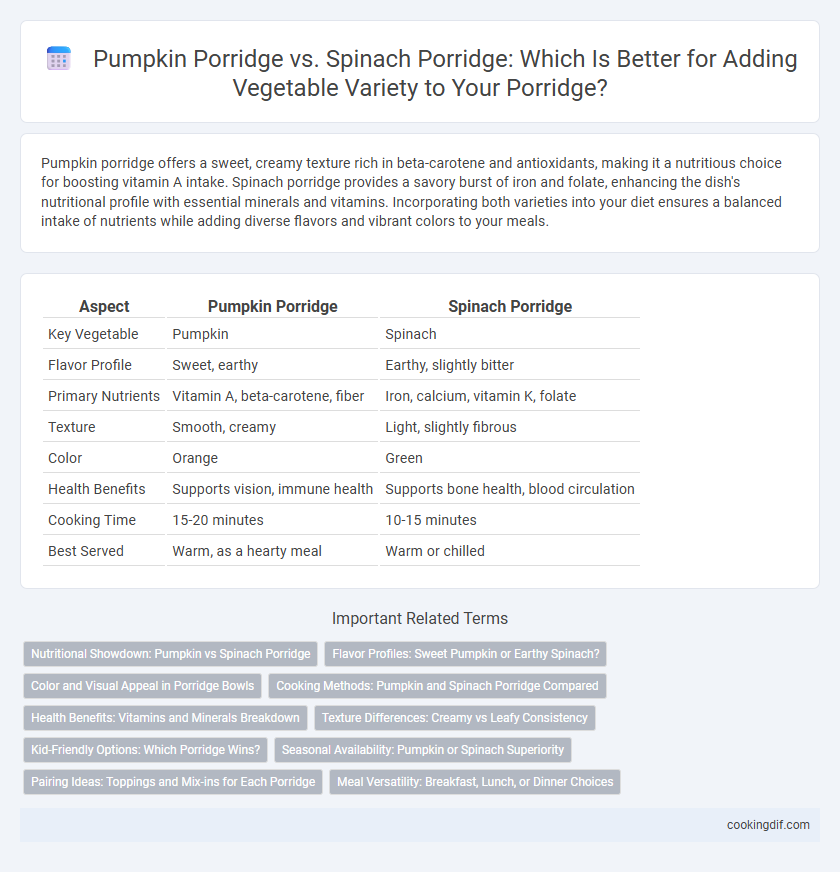Pumpkin porridge offers a sweet, creamy texture rich in beta-carotene and antioxidants, making it a nutritious choice for boosting vitamin A intake. Spinach porridge provides a savory burst of iron and folate, enhancing the dish's nutritional profile with essential minerals and vitamins. Incorporating both varieties into your diet ensures a balanced intake of nutrients while adding diverse flavors and vibrant colors to your meals.
Table of Comparison
| Aspect | Pumpkin Porridge | Spinach Porridge |
|---|---|---|
| Key Vegetable | Pumpkin | Spinach |
| Flavor Profile | Sweet, earthy | Earthy, slightly bitter |
| Primary Nutrients | Vitamin A, beta-carotene, fiber | Iron, calcium, vitamin K, folate |
| Texture | Smooth, creamy | Light, slightly fibrous |
| Color | Orange | Green |
| Health Benefits | Supports vision, immune health | Supports bone health, blood circulation |
| Cooking Time | 15-20 minutes | 10-15 minutes |
| Best Served | Warm, as a hearty meal | Warm or chilled |
Nutritional Showdown: Pumpkin vs Spinach Porridge
Pumpkin porridge offers a rich source of beta-carotene and vitamin A, essential for eye health and immune support, while spinach porridge delivers high levels of iron, calcium, and folate, crucial for blood health and bone strength. Both porridges are low in calories and packed with dietary fiber, promoting digestive health and satiety. Choosing between pumpkin and spinach porridge depends on specific nutrient needs, with pumpkin supporting antioxidant intake and spinach enhancing mineral and vitamin density.
Flavor Profiles: Sweet Pumpkin or Earthy Spinach?
Pumpkin porridge offers a naturally sweet and creamy flavor, enriched with subtle nutty undertones that complement its smooth texture. Spinach porridge delivers an earthy, slightly bitter taste with a fresh green aroma that adds complexity and a nutritional boost. Choosing between sweet pumpkin and earthy spinach porridge depends on whether you prefer a comforting, mildly sweet dish or a savory, nutrient-dense option for vegetable variety.
Color and Visual Appeal in Porridge Bowls
Pumpkin porridge boasts a vibrant orange hue that creates a warm and inviting visual appeal, enhancing the overall presentation of a porridge bowl. Spinach porridge, with its rich green color, offers a fresh and earthy appearance that contrasts well with other ingredients. Incorporating both vegetables in porridge bowls not only diversifies the color palette but also elevates the visual attractiveness, making the meal more appetizing.
Cooking Methods: Pumpkin and Spinach Porridge Compared
Pumpkin porridge typically requires roasting or steaming the pumpkin before blending it into the porridge, enhancing its naturally sweet and creamy texture, while spinach porridge involves lightly sauteing or steaming the spinach to retain its vibrant color and delicate flavor. Pumpkin's dense flesh benefits from longer cooking times to soften, whereas spinach cooks quickly, often added towards the end to preserve its nutrients and freshness. These differences in cooking methods result in distinct textures and flavors, offering varied vegetable experiences in porridge recipes.
Health Benefits: Vitamins and Minerals Breakdown
Pumpkin porridge is rich in beta-carotene, vitamin A, and potassium, which support eye health and immune function, while spinach porridge offers high levels of iron, calcium, and vitamin K essential for blood health and bone strength. Both provide dietary fiber for digestive health, but pumpkin porridge has a higher antioxidant content due to its carotenoids. Incorporating both pumpkin and spinach porridge into meals maximizes vitamin and mineral diversity for balanced nutrition.
Texture Differences: Creamy vs Leafy Consistency
Pumpkin porridge offers a creamy and smooth texture due to the natural softness of cooked pumpkin, making it rich and velvety on the palate. Spinach porridge delivers a leafy and slightly fibrous consistency, providing a more textured and earthy mouthfeel with visible greens. Choosing between pumpkin and spinach porridge enhances vegetable variety by balancing creamy softness with leafy freshness in your diet.
Kid-Friendly Options: Which Porridge Wins?
Pumpkin porridge offers a naturally sweet flavor and vibrant orange color that appeals to kids, making it a popular vegetable variety choice for children. Spinach porridge, rich in iron and vitamins, provides a nutritional boost but may require added sweetness or mild seasoning to please picky eaters. Pumpkin porridge often wins in kid-friendly preference due to its milder taste and appealing texture, encouraging vegetable intake with ease.
Seasonal Availability: Pumpkin or Spinach Superiority
Pumpkin porridge excels in seasonal availability during autumn and early winter, offering rich beta-carotene and a naturally sweet flavor, while spinach porridge thrives in spring and summer with high iron and vitamin K content. Choosing pumpkin or spinach porridge depends largely on the local harvest cycle, ensuring maximum freshness and nutrient density in each dish. Seasonal selection not only enhances taste but also supports sustainable consumption and nutritional balance in vegetable-based porridges.
Pairing Ideas: Toppings and Mix-ins for Each Porridge
Pumpkin porridge pairs well with warm spices like cinnamon and nutmeg, complemented by mix-ins such as toasted pecans, dried cranberries, and a drizzle of maple syrup for a rich, autumnal flavor. Spinach porridge benefits from savory toppings like feta cheese, sun-dried tomatoes, and a sprinkle of toasted pine nuts, enhancing its earthy taste while adding texture. Both porridges can be elevated with fresh herbs like parsley or chives, creating a balanced and nutrient-rich vegetable variety breakfast option.
Meal Versatility: Breakfast, Lunch, or Dinner Choices
Pumpkin porridge offers a naturally sweet, creamy texture ideal for breakfast, providing a comforting start rich in beta-carotene and fiber. Spinach porridge delivers a savory, nutrient-dense option loaded with iron and vitamins A and C, suitable for lunch or dinner meals. Both variants enhance vegetable variety and meal versatility, adapting easily to sweet or savory seasonings to fit diverse dietary preferences throughout the day.
Pumpkin Porridge vs Spinach Porridge for Vegetable Variety Infographic

 cookingdif.com
cookingdif.com